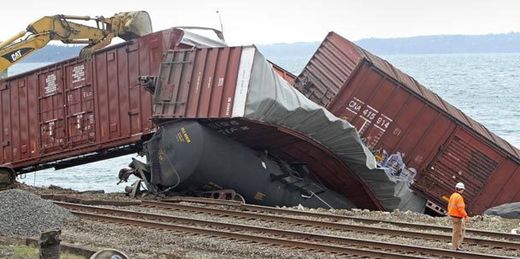
Hazardous chemicals that spilled from a derailed freight train onto the banks of the Puget Sound on Saturday night could have produced an environmental catastrophe in Pierce County, according to a state Department of Ecology official.
But only 50 gallons of highly corrosive sodium hydroxide, or lye, hit the shore in University Place near Tacoma, Ron Holcomb, a state hazardous-materials specialist, said Sunday. Holcomb said the lye would be diluted as it comes in contact with water, and any damage to aquatic life would "probably not be obvious."
"We're very fortunate," Holcomb said.
Four tank cars, each containing about 15,000 gallons of lye, were derailed near the shore. Only one car leaked, from two places, a valve and a hatch, he said. Emergency crews were able to seal and reduce those leaks to a drip by Sunday morning.
Four tank cars, each containing about 15,000 gallons of lye, were derailed near the shore. Only one car leaked, from two places, a valve and a hatch, he said. Emergency crews were able to seal and reduce those leaks to a drip by Sunday morning.
"When a fully loaded tank car leaves the track, there are tremendous forces at play and potential for serious damage. In this case, we're fortunate there was just a minor leak of this hazardous material," Holcomb said.
Fourteen cars from two trains derailed Saturday night, and most were empty, BNSF Railway spokesman Gus Melonas said.
The chemical is used in industry to unclog drains and regulate the pH levels of water, but it can be hazardous and cause breathing problems and burns.
No one was injured in the derailment, which occurred about 8:30 p.m. 13 miles south of Tacoma, Melonas said. None of the cars went into the water, and none of the lye appears to have spilled directly into the water, he said.
Melonas said no evacuations had been ordered, though there are some homes in the area.
"Not much of the chemical leaked, and there were no vapors," he said. "A hazmat team determined that there was no public threat."
The accident occurred as a 103-car BNSF train was heading north from Portland. The train derailed, and some of its cars struck a freight train traveling in the opposite direction.
Twelve cars on the northbound train derailed, as did two on the southbound train. The hazardous chemicals are being pumped out of the tank cars and into trucks and hauled away, Melonas said.
The cause of the initial derailment remained under investigation Sunday.
The two parallel BNSF tracks running between Portland and Seattle initially were closed. Melonas said one reopened Sunday afternoon, and he expected the other to reopen by midnight. He added that 60 trains use those tracks daily and some would be rerouted.
The accident also forced Amtrak to adjust some passenger-train routes and cancel one line, said spokesman Steve Kulm. The Coast Starlight route Saturday night from Los Angeles to Seattle ended in Olympia instead. And, Sunday, the 4:25 p.m. train from Seattle to Los Angeles started in Portland. Passengers in Seattle were shuttled to Portland by bus. Cascade service, the regional line between Seattle and Portland, was canceled Sunday.
Responders to the derailment included the Pierce County Hazardous Incident Team, the Coast Guard, the state Department of Ecology, BNSF, the Anderson Island Fire Boat and the Guardian One Helicopter from the King County Sheriff's Office.
The Coast Guard is establishing a safety zone near the derailment because of the volatility of sodium hydroxide. Sodium hydroxide can create toxic gases when mixed with water and can cause burns to the respiratory tract, skin, eyes and gastrointestinal tract, according to an Emergency Response Guide and Marine Safety Data Sheet.
A broadcast notice warned local boaters to keep clear of the area. Coast Guard personnel were working with the multiple agencies to evaluate the situation and determine how to proceed.
The Associated Press and Seattle Times staff reporter Marian Liu contributed to this report.



Reader Comments
to our Newsletter